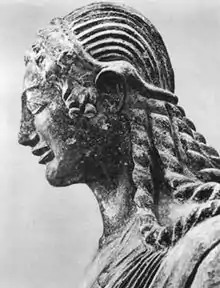Tabula Capuana
The Tabula Capuana (=Tablet from Capua Ital. Tavola Capuana),[1] is an ancient terracotta slab, 60 by 50 centimeters, with a long inscribed text in Etruscan, apparently a ritual calendar,[2] of which about 390 words are legible. It is located in the Altes Museum, Berlin.[3] It is the second-most extensive surviving Etruscan text.[4] (The longest is the linen book (Liber Linteus) used in ancient Egypt for mummy wrappings, now at Zagreb.)
_(14590929287).jpg.webp)
_-_Altes_Museum_-_Berlin_-_Germany_2017.jpg.webp)
Description
Horizontal scribed lines divide the text into ten sections. The writing is most similar to that used in Campania in the mid 5th century BC, though surely the text being transcribed is much older. It is an archaic ten-month year beginning in March (Etruscan Velxitna).
Attempts at deciphering the text (Mauro Cristofani, 1995) are most generally based on the supposition that it prescribes certain rites on certain days of the year at certain places for certain deities. The text itself was edited by Francesco Roncalli, in Scrivere etrusco 1985.[5]
Discovery
The tablet was uncovered in 1898 in the burial ground of Santa Maria Capua Vetere.[6]
References
- Mauro Cristofani (1995). Tabula Capuana. L.S. Olschki.
- Jörg Rüpke (4 February 2011). The Roman Calendar from Numa to Constantine: Time, History, and the Fasti. John Wiley & Sons. pp. 12–. ISBN 978-1-4443-9652-2.
- "Tabula Capuana - Unknown". Google Arts & Culture. Retrieved 2019-07-17.
- "Tabula Capuana - Unknown". Google Arts & Culture. Retrieved 2019-07-17.
- Scrivere etrusco: dalla leggenda alla conoscenza, scrittura e letteratura nei massimi documenti della lingua etrusca. Electa editrice. 1985.
- Sinclair Bell; Alexandra A. Carpino (9 December 2015). A Companion to the Etruscans. Wiley. pp. 210–. ISBN 978-1-118-35498-8.
